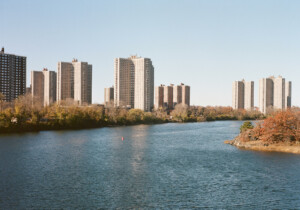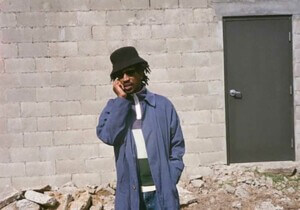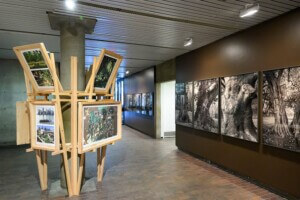We’ve been bombarded on the blog with increasingly insidious spam over the past few months, which led us to installing CAPTCHA to filter out the bots from the peeps. Hopefully it doesn’t cause too much of a problem to all you commenters out there.
Meanwhile, as we tried to clean out much of that spam, we came across two particularly compelling comments (not that the rest of you aren’t special). The first were these great photos of the Baldwin Hill Scenic Overlook and the second was a particularly poetic remembrance of Max Bond that appeared some three months after his death. You can find both after the jump.
An Architect Plans For Peaceful Plains
by Frederick B. Hudson
The poet Kahlil Gibran hoped that the sons and daughters of the universe not dwell in tombs made by the dead for the living. The native of Lebanon encouraged them to hope that the valleys were your streets, and the green paths your alleys, that you might seek one another through vineyards, and come with the fragrance of the earth in your garments.
The lyrical dreams have come to fruition in the career of J. Max Bond, Jr., an internationally known architect whose buildings ranging from libraries to cultural centers in sites as diverse as Zimbabwe and Harlem, New York have included the dreams and aspirations of those who inhabit them.
Mr. Bond, a graduate of Harvard College and Harvard Design School, has for over forty years sought sustainable development for the citizens of the world. Defined by urban planners as “development that meets the needs of the present without compromising the ability of future generations to met their own needs, this concept has found credibility within the United Nations and other allied organizations within the last twenty years.
Max Bond started on his quest for this inclusive value system in Ghana in 1964 as an architect for the Ghana National Construction Company. He designed the Bolgatanga Library. He took the needs of the culture in consideration in the design of this project by organizing the space in consideration for the needs of the users of the research facility to meet and share information within the cultural context of African arts and culture.
These concerns have marked his work since he feels that the European Bauhaus method of architecture which feels that architecture should be responsive to the needs and influences of the modern industrial world.
Bond feels that some housing in Harlem reflects society’s lack of concern for the residents-it is very stark and similar and makes the people in it almost anonymous. He notes that some cities have had to destroy this type of public housing because the social disruption is so intense that it renders life unbearable.
“Public housing in Harlem tends to dehumanize the residents It does not make the residents feel that they own the housing. The firms that designed this housing after World War II were not minority owned firms, they went along with the standard concept of the time which was about warehousing people. “In contrast some of the first public housing in Harlem which was the East River housing was designed by a mixed race group of architects in the ’30s was very warm and welcoming to the residents. You enter the houses through courtyards. There is a lot of sculpture in the courtyards which was done by the WPA. It is very humane.”
These concerns propelled Bond to establish and lead the Architects Renewal Committee of Harlem(ARCH) in the late 1960s. He was inspired by the presence of brownstones in Harlem which reflected a desire to provide good , stable housing for the middle class in the early 20th century. He and a staff of other architects and lawyers stove to provide poorer community residents with options that they could present to city officials and planning boards as alternatives to establishment plans for renovation and renewal. He encouraged them to consider the effects of neighborhoods plans on the development of neighborhoods.
Always the educator, he rose from assistant professor to Chairman of Colu mbia University Graduate School of Architecture and Planning from 1970 to 1985. Among his private commissions during this time was the design of the Arthur Schomburg Center for Research in Black Culture. He feels that the construction of this building was a prototype of how architects can best serve their community. Jean Blackwell Hutson at first presided over a decaying Carnegie library building where the collection was housed, but through a personal campaign secured public money to construct a new facility after library officials had ignored her pleas for support.
Bond intentionally designed the building in 1979 using masonry rather that from glass and steel since more black laborers had skills in these areas. He got very involved in the contracting out of labor to make sure that minority workers got ample share of the work. His design plans specified that the wood used for the paneling and the tables were to be made from a certain type of African wood. When the contractors asks where the wood could be found, he led them to an African company based in the World Trade Center who could supply the wood. No excuses allowed!
He says he was able to do this fundamentally because he cared. His concern coupled with a strong advisory board was able to wield influence in the corridors of powers to bring diversity to this effort.
When he was asked to design the new university in Zimbabwe, he tried to understand what materials could be supplied locally as well as what concerns were appropriate for the climate there. He designed an environment which provided an updraft which would cool the building during the day with materials that would hold heat during the night for warmth. This is true planning for the future. He also designed the roofs for rainwater collection and reuse.
Concerns for maximum use of local labor was incorporated in the design plans. Laborers in the country had been exploited for years by colonial powers and had skills, but they had been denied managerial responsibilities. Bond and his team made every effort to specify use of materials that local natives had worked with in the past, thus creating career paths for local residents.
Bond sees buildings as potential magnets for human activity and interaction-his designs for the Martin Luther King Jr. Center for Nonviolent Social Change and the Birmingham Civil Rights Museum reflect his desire for people of good will to meet on common ground for understanding.
He recently had significant concerns about the planning process used to rebuild the destroyed twin World Trade Center Towers since he felt that all types of people should have consulted about the use of the land. ” There was an immediate decision to rebuild the commercial use of the land. But all kinds of people should have been consulted about the very use of the land. It could have been a park or anything. Poets, dancers, artists as well as architects should have been consulted about this space which was created by tragedy.”
Bond contrasts this exclusive process of land use to the African Burial Ground in Lower Manhattan where the minority community rose up when the bones of their ancestors were discovered beneath public property. “People demanded change.”
A true visionary, Bond is committed to reminding residents of the world’s cities and villages of the admonition of Gibran: In their fear your forefathers gathered you too near together. And that fear shall endure a little longer. A little longer shall your city walls separate your hearths from your fields.










